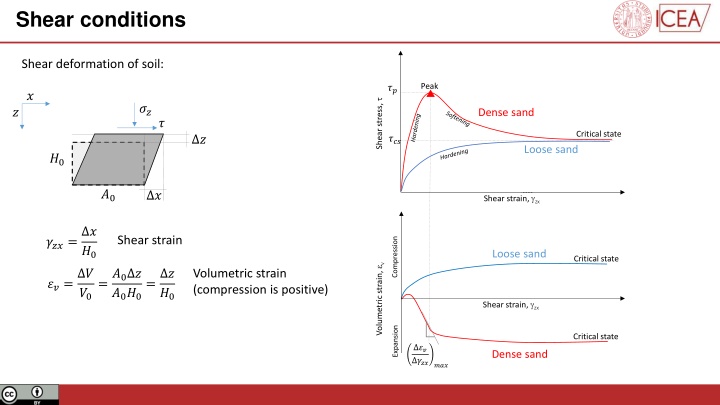
Understanding Shear Conditions in Soil Mechanics
Learn about shear deformation of soil, peak shear stress, critical state, types of soils under shearing conditions, drained vs undrained conditions, and more in soil mechanics and foundations. Explore the differences between Type I and Type II soils and how they behave under various loading conditions.
Download Presentation

Please find below an Image/Link to download the presentation.
The content on the website is provided AS IS for your information and personal use only. It may not be sold, licensed, or shared on other websites without obtaining consent from the author. If you encounter any issues during the download, it is possible that the publisher has removed the file from their server.
You are allowed to download the files provided on this website for personal or commercial use, subject to the condition that they are used lawfully. All files are the property of their respective owners.
The content on the website is provided AS IS for your information and personal use only. It may not be sold, licensed, or shared on other websites without obtaining consent from the author.
E N D
Presentation Transcript
Shear conditions Shear deformation of soil: Peak Shear stress, ?? ? ?? ? Dense sand ? Critical state ? ??? Loose sand ?0 ?0 ? Shear strain, zx ???= ? Shear strain Compression ?0 Loose sand Critical state Volumetric strain, v ??= ? =?0 ? ?0?0 = ? ?0 Volumetric strain (compression is positive) ?0 Shear strain, zx Expansion Critical state ?? ??? Dense sand ???
Shear conditions Consider 2 types of soil under shearing conditions (drained) Type I soils loose sands, normally consolidated and lightly overconsolidated clays (OCR < 2): gradual increase in shear stresses (strain-hardens) until the critical state shear stress. Compress during shearing Residual state Type II soils dense sands and heavily overconsolidated clays (OCR>2): rapid increase in shear stress reaching a peak value at low shear strains and then show a decrease in shear stress with increasing shear strain (strain-softens), ultimately attaining a critical state shear stress. Initially compress a bit, but then dilate during shearing (DILATANCY). Budhu, M. (2008). Soil mechanics and foundations. Wiley Textbooks.
Undrained conditions Drained condition occurs when the excess pore water pressure developed during loading of a soil dissipates, i.e., u= 0. (typical of sand, and clay at long term) Undrained condition occurs when the excess pore water pressure cannot drain, at least quickly, from the soil, ? 0. (typical of clay at short term) Budhu, M. (2008). Soil mechanics and foundations. Wiley Textbooks.
Undrained conditions v a Undrained conditions Drained conditions ?1 v ?1 Water can not flow out/in Water flows out/in ?3 v=0 v 0 ?3 ?3 ?3 u 0 u=0 ?1 ?1 Compression (+) Pressure (+) Normally consolidated clay Normally consolidated clay Excess pore pressure, u Critical state Critical state Volumetric strain, v Axial strain, a Axial strain, a Expansion (-) Suction (-) Critical state Critical state Overconsolidated clay Overconsolidated clay






















